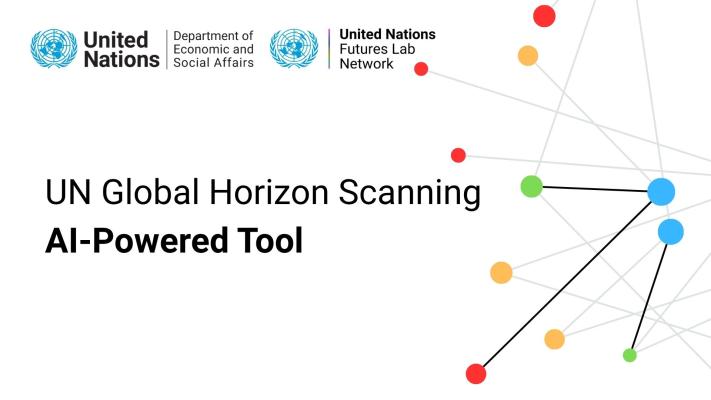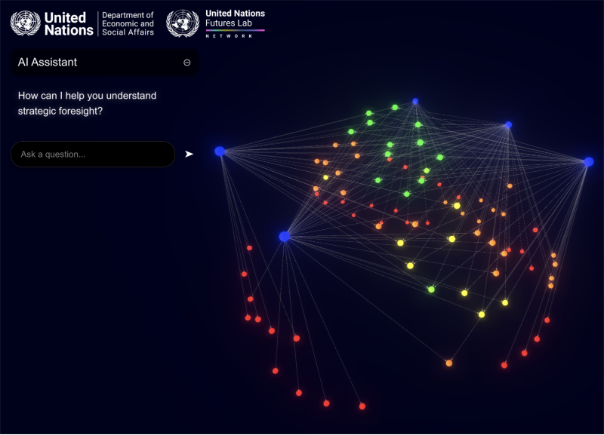
Anticipating Change, Shaping the Future
The world is experiencing a period of rapid and profound transformation — marked by geopolitical fragmentation, economic uncertainty, widening inequalities, climate change, demographic shifts, and breakthrough technologies such as artificial intelligence.
To navigate this complexity, global and national institutions must strengthen their capacity for strategic foresight — the ability to anticipate emerging challenges and opportunities, and to translate insights into action.
Horizon scanning is a key foresight method that connects diverse perspectives to map possible futures. Across the UN system, multiple horizon scanning efforts have produced valuable insights on signals, trends, and drivers of change.
What Is the UN Global Horizon Scanning AI-Powered Tool?
The UN Global Horizon Scanning AI-Powered Tool is a system-wide initiative designed to enhance forward-looking planning, programming, and decision-making across the UN’s work.
By drawing on existing foresight knowledge, the tool enables users to:
Analyze and visualize foresight outcomes through an AI-powered assistant and knowledge management interface;
Strengthen institutional learning and coherence by identifying synergies across UN foresight and futures-thinking initiatives; and
Support the design of anticipatory, SDG-aligned policies and programmes to navigate uncertainty and complexity.
The tool provides an integrated digital platform where users can explore trends and drivers shaping sustainable development, visualize relationships between signals, and generate insights to inform strategic decisions.

How Was It Developed?
From Governance Futures to a Foresight Tool
The tool was conceptualized and engineered through a collaboration between the UN Department of Economic and Social Affairs (UN DESA) and the UN Futures Lab, established by the Executive Office of the Secretary-General in 2023.
The concept of the UN Global Horizon Scanning AI Tool originated out of the UN Economist Network’s foresight initiative.
The collaboration entailed conducting a strategic foresight process in support of a UNEN Policy Brief, culminating in the publication of the UNEN Policy Brief on Governance Futures. It also provided an opportunity to test and refine AI and visualization tools for strategic foresight developed by UN DESA, through its Division for Public Institutions and Digital Government (DPIDG), particularly those applied to the findings of a jointly conducted horizon scanning online survey on governance futures with the participation of over twenty UN entities.
Recognizing the need to consolidate and leverage this collective intelligence, UN DESA and the UN Futures Lab/Global Hub expanded their collaboration to explore how digital innovation and AI could make foresight knowledge more accessible, actionable, and system wide.
The tool was developed entirely in-house, showcasing DPIDG’s leadership in applying artificial intelligence to accelerate the achievement of the Sustainable Development Goals (SDGs).
A distinctive feature of this AI tool is its transparency. Unlike “black box” systems, users can visualize how the AI reaches its conclusions. When a user submits a query, the system displays a 3D interactive graph that reveals the connections between concepts and the sources of information used in reasoning. This transparency fosters trust, accountability, and collaboration between human experts and machine intelligence.
Technical Overview
The tool uses a Three.js frontend to render an interactive 3D knowledge graph and a Neo4j graph database on the backend to manage complex relationships. Its retrieval-augmented generation (RAG) pipeline leverages advanced language models to query the graph and highlight the specific nodes and relationships behind each response.
This is the first GUI developed to visualize graph retrieval in a foresight application within the UN system.
Milestones and Next Steps
- December 2024: Collaboration between UN DESA/DPIDG and the UN Futures Lab begins to conceptualize the UN Global Horizon Scanning AI-Powered Tool.
- February 2025 – October 2025: The tool is currently in beta testing, with ongoing enhancements based on user feedback.
- May 2025: The first live demo of the prototype took place at a side event co-hosted by UN DESA and the UN Futures Lab during the 2025 Science, Technology and Innovation (STI) Forum. The initial version integrates five horizon scanning reports (2022–2024) from UN DESA, FAO, UNDP, UNEP, and WHO.
- 5 November 2025: UN Futures Lab/Global Hub and UN Department of Economic and Social Affairs (UN DESA) for a Solutions Session at the Second World Summit for Social Development 2025: UN Global Horizon Scanning for Governance and Social Development.
- December 2025: Launch expected.
Contacts
UN DESA/DPIDG
For further information:
About the initiative:
Adriana Alberti, Chief, Programme Management and Capacity Development Unit, DPIDG, UN DESA — alberti@un.org
Engineering:
Gregory McGann, Programme Management and Capacity Development Unit, DPIDG, UN DESA — gregory.mcgann@un.org
UN Futures Lab
 Welcome to the United Nations
Welcome to the United Nations